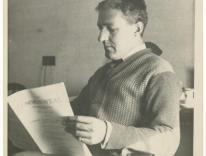Then Herod, when he saw that the had been tricked by the Wise Men, was in a furious rage, and he sent and killed all the male children in Bethlehem and in all that region who were two years old or under, according to the time which he had ascertained from the Wise Men. Thus was fulfilled what was spoken by the prophet Jeremiah:
A voice was heard in Ramah,
Wailing and loud lamentation,
Rachel weeping for her children;
She refused to be consoled,
Because they were no more Matthew 2:16-17
Each night before I put him in his crib, I sing the Salve Regina to my son. We have been performing this little ritual almost every day of his almost six months of life. And, as you might imagine, the words "gementes et flentes/ in hac lacrimarum valle" have taken on a deeper valence the last couple of weeks, and will certainly do so again tonight on this Feast of the Holy Innocents.It's a curious feature of English that the word tear means two quite different things and is pronounced in two different ways. We mourn and weep in the valley of tears, but these tears are often caused by tears, wounds, in our communities, our relationships, and our bodies.
No doubt the holy family suffered both kinds of tears during and immediately after Jesus birth. Certainly Jesus cried when he was hungry. Its a safe bet that Mary's body bore tears from the birth, tears that would take weeks to heal. Mary and Joseph must have been psychologically torn -- aren't all new parents? -- by (even slight) postpartum depression, by their accommodations (or lack thereof) in Bethlehem, by Joseph's dream that the family needed to flee to Egypt. And about that trip to Egypt: Was Mary able to walk? Did Jesus get a good latch for nursing? Was Joseph keeping his wits about him as he was to make the long journey from Bethlehem? How many arguments did the couple get into on the road? How many tears were shed?
Matthew is silent about the mothers and fathers in Bethlehem whose sons were slaughtered. He doesn't tell us if they tried to understand the plan of a God who had allowed a tyrant to tear their boys bodies. Matthew makes the connection to the Book of Jeremiah, but he doesn't tell his readers if the parents saw themselves as Rachel. He doesn't tell us many tears those parents shed.
And why do we celebrate that massacre today?As with all feast days, there is no one single answer that can explain the spiritual depth of the day and the event it celebrates. But I have been thinking about the relationship between prayers and tears. The French philosopher Jean-Louis Chrtien argues that prayer ought to be understood as wounded speech. In an essay entitled, "The Wounded Word," he writes that prayer always has its origin in the wound of joy or distress, it is always a tearing that brings it about that the lips are open. And it does so as it is still and otherwise wounded. To pray is to be vulnerable before God and before ourselves. And prayer doesnt decrease that vulnerability. We hope that the vulnerability allows for an intimacy that wouldn't exist without it. Tears open the lips in prayer, but prayer does not heal or stop the tears. Prayer keeps the tears open and the tears flowing. The Spirit helps us in our weakness, Paul tells the Romans, for we do not know how to pray as we ought, but the Spirit himself intercedes for us with sighs too deep for words (Rom 8:26). We can't even be consoled by knowing that were praying the right way. The consolation and joy that Mary and Joseph experienced because of the birth of a healthy son quickly became enmeshed in a host of rather different emotions and considerations. They too mourned and wept. They too lived in the valley of tears.Some tears obviously deepen our relationships; other tears are inscrutable.
I don't pretend to practice theodicy. I have always found Job's questions more illuminating than Liebniz's answers. Massacres of children in the twenty-first century make as little sense as they did in the first. Like Rachel and Job and Mary and Joseph and the parents in Bethlehem we weep because we are torn. Our tears become our prayers.


